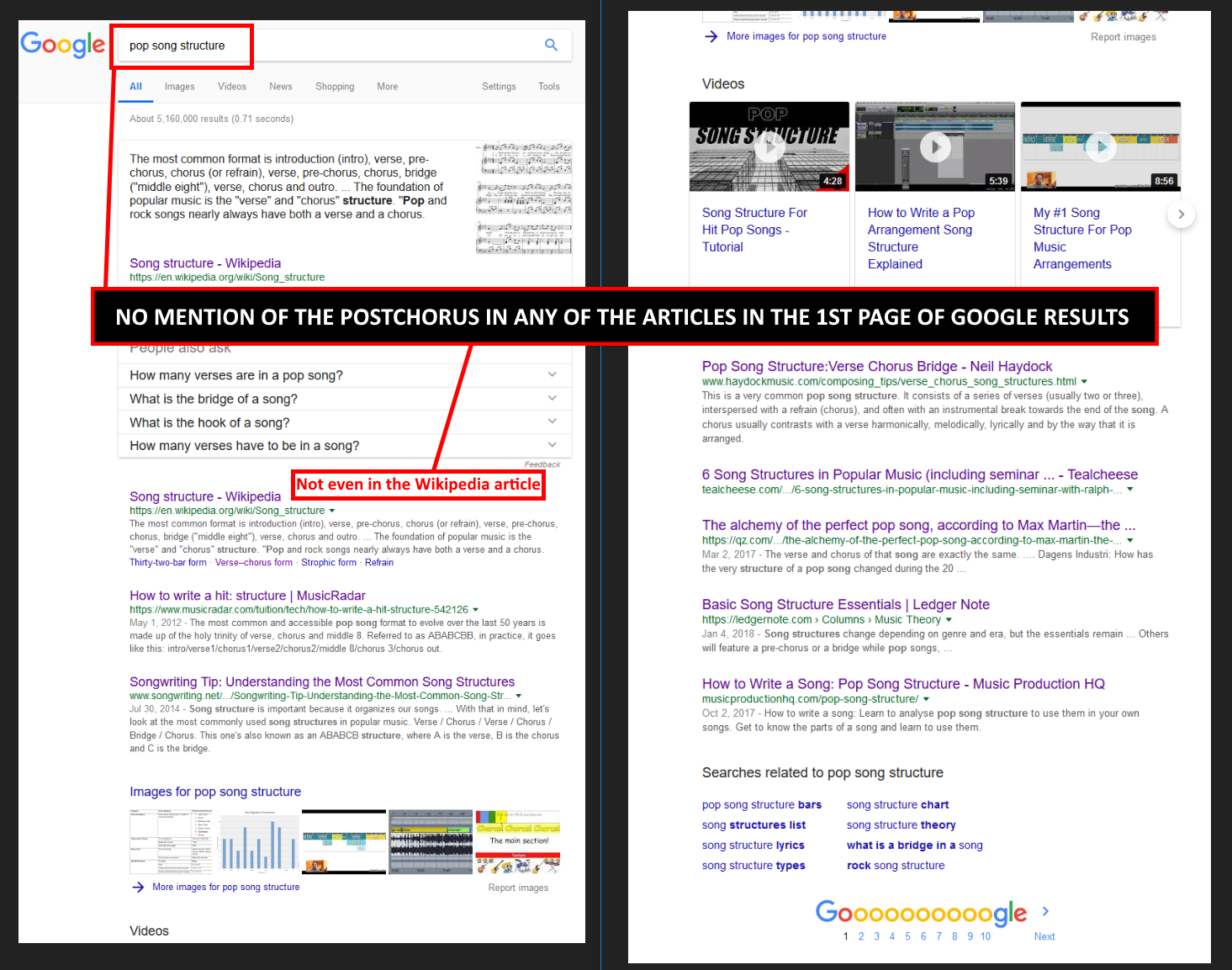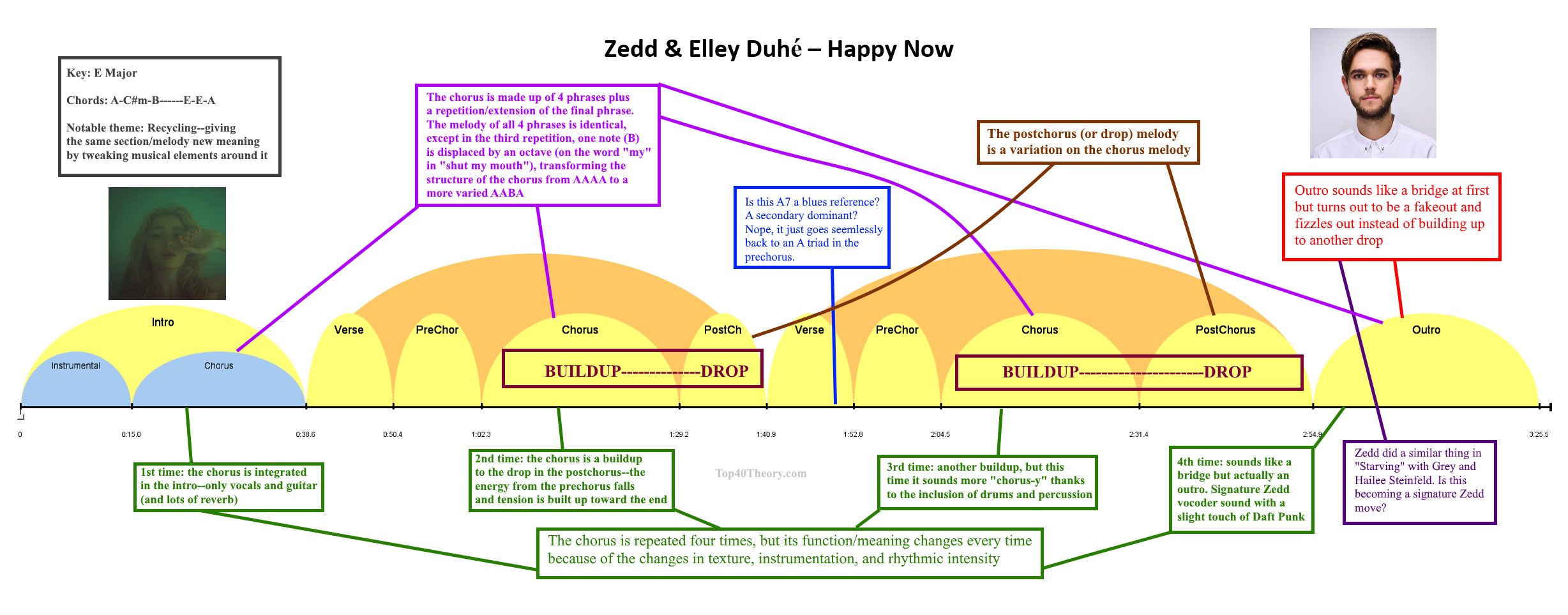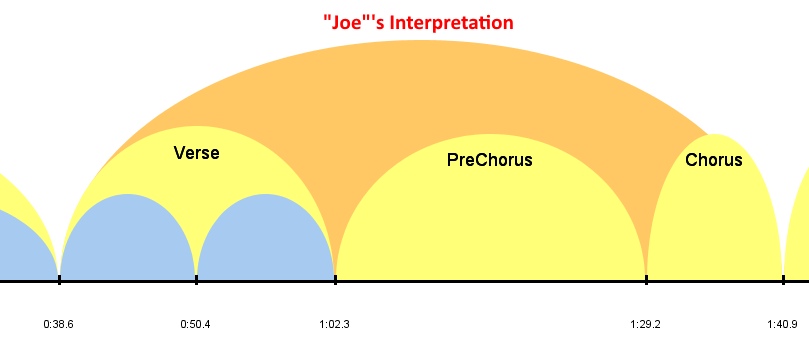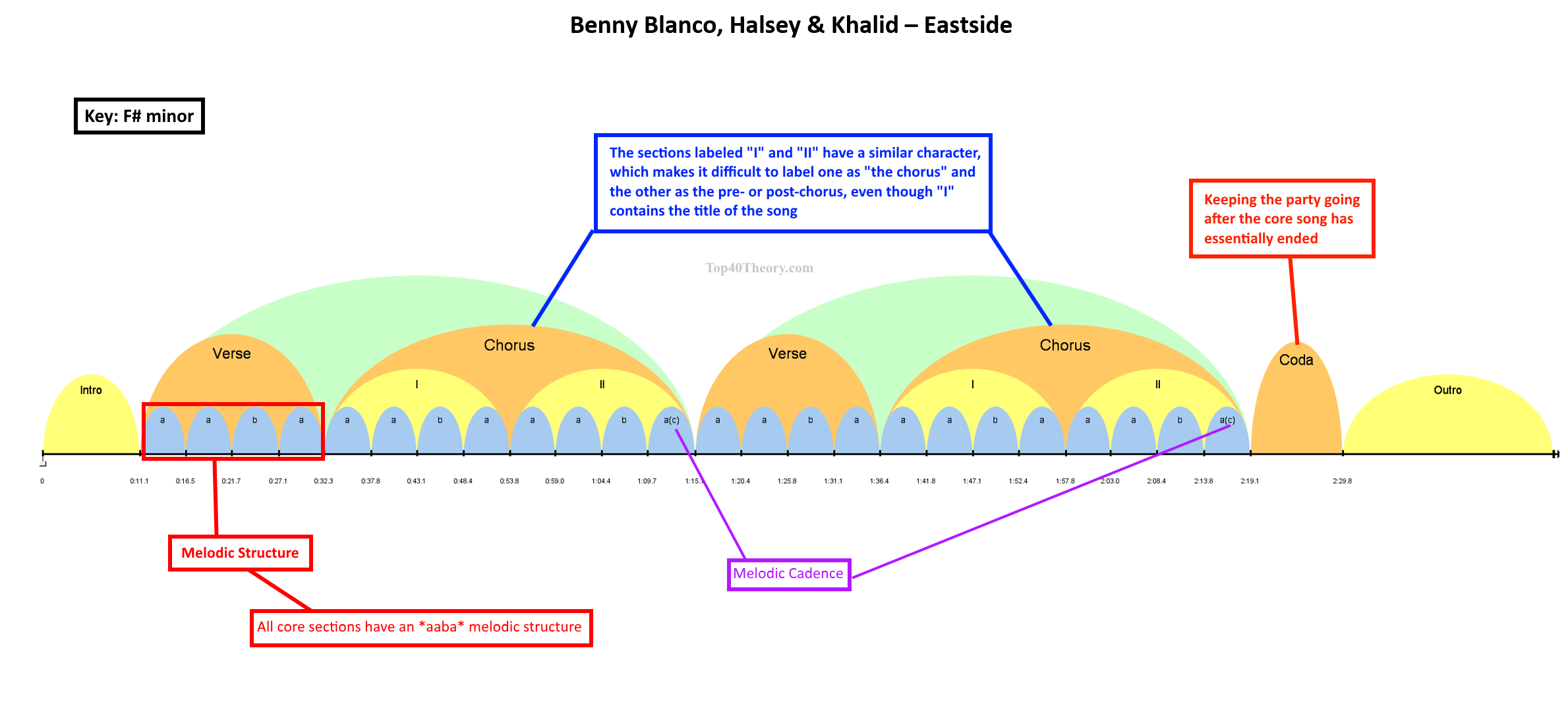Asaf Peres
Everything You Need to Know About the Postchorus
If you follow this blog or my posts on social media, you've probably heard the term "postchorus" from me more times than you've heard it elsewhere in your entire life.
I'm not sure why, but the everyday discourse about pop music, and song structure in particular, does not include the postchorus very often, despite its explosion in popularity over the last decade.
In fact, I googled "pop song structure" and was stunned to discover that none of the results on the first page mention the post chorus. Not even the Wikipedia article...

As a music theory blog about pop music, I couldn't in good conscience let this travesty continue any longer.
In my opinion, it's silly to discuss the pop song structure without mentioning the postchorus. For one, it's a huge omission--I haven't done an empirical study but my educated guess is that the majority of hit pop songs from recent years include postchoruses.
But more importantly, not recognizing the postchorus can lead to a misunderstanding of the entire structure of a song. For example, I recently had a pleasant exchange with a musician who was wondering why I decided to label the chorus and postchorus as I did in my following visual analysis of Zedd & Elley Duhé's new song, "Happy Now":

This person--let's call him Joe--would have interpreted the section between ~0:38-1:41 as follows:

I can see the merit in this interpretation from a pure production standpoint. It correlates three sonic functions--setup, buildup, and climax--with their traditionally respective song sections.
However, since the process of composing pop songs has truly become a collaborative venture between songwriter(s) and producer(s), it has become more and more common for the production dimension to diverge from the songwriting dimension, and it's important to recognize both dimensions in order to truly understand the function of each section.
Labeling the section between 1:02-1:29 as a prechorus ignores the fact that it contains the main vocal hook, as well as the title of the song. From a songwriting perspective, this is the central section of the song, which merits naming it the chorus.
In addition, labeling it as a prechorus played a role in Joe's decision to lump the previous two sections (0:38-0:50 and 0:50-1:02) as a single verse. While Joe is right to observe no significant sonic separation between these two sections, there is a clear melodic contrast, and the lyrics of 0:50-1:02 repeat as-is in the next cycle, which is common in prechoruses and almost unheard of in verses.
Recognizing the postchorus, however, makes all the other pieces fall into place. The prechorus and chorus are recognized for what they are, and the structural sequence becomes more straightforward.
This doesn't mean that Joe's interpretation is invalid. I just think that it is best suited as an interpretation of the sonic functions of the song, and not of the song sections. In any case, a complete analysis should include both dimensions.
HOW TO IDENTIFY A POSTCHORUS
Now that we have established the importance of recognizing the postchorus, we can proceed to discuss its core traits and various forms.
Although there are some exceptions, if one of those three things isn't there, it's likely not a postchorus.
The postchorus has three primary traits:
- It comes immediately after the chorus (duh).
- It cranks up the sonic energy from the chorus, or at the very least maintains the same level of sonic energy as the chorus.
- It contains a melodic hook--either vocal or instrumental.
Although there are some exceptions, if one of those three things isn't there, it's likely not a postchorus.
If the sonic energy drops after the chorus, you're probably in the second verse or the bridge.
If it doesn't contain a melodic hook, it's likely a transition and not a postchorus.
If it doesn't come after the chorus... well, I don't think I need to explain why that's not a postchorus either.
POSTCHORUS TYPES
Although nearly all postchoruses have the traits I listed above in common, they differ from each other in various ways. I have identified four main postchorus categories.
1. The Attached Postchorus
The attached postchorus is a direct extension of the chorus. With very little, if any, sonic separation from the chorus, the attached postchorus carries on with the main hook while omitting the 'story' from the chorus. Examples include:
Maroon 5 - Girls Like You - postchorus starts 0:54
Halsey - Bad at Love - postchorus starts 1:51
Selena Gomez - Good for You - postchorus starts 1:59
2. The Detached Postchorus
The detached postchorus can be thought of as an additional chorus. It builds on the high energy of the chorus but contains its own unique melody and hooks.
It's not quite as common as the other types of postchorus, but as the examples below will show, the detached postchorus is very effective in certain contexts, such as when there is more than one lead singer (Despacito); when it's a two-cycle form with no bridge and there's a need for an extra melody (Chandelier); and when a new melody is needed to break up the would-be excessive repetition of the main hook (Till the World Ends).
Justin Bieber, Luis Fonsi & Daddy Yankee - Despacito - postchorus starts 1:25
Britney Spears - Till the World Ends - postchorus starts 2:34
3. The Hybrid Postchorus
This is perhaps the most common type of "pure pop" postchorus. It combines the traits of the attached and detached postchoruses.
Like the attached postchorus, the hybrid version isolates the main hook from the chorus, but instead of keeping the focus exclusively on this hook, the hybrid postchorus adds another melody/hook to the mix as a counterpoint to the chorus hook. For example:
Charlie Puth - How Long - postchorus starts 1:05
Troye Sivan & Ariana Grande - Dance to This - postchorus starts 1:18
Selena Gomez - Hands to Myself - postchorus starts 2:08
4. The Pop-Drop
Charlie Harding from the Switched On Pop podcast coined this term in a post he wrote for Billboard. "Pop-drop" perfectly describes this type of postchorus, which juxtaposes the EDM buildup-drop sequence with the pop song form. If the hybrid postchorus is a pure-pop staple, the pop-drop is almost an obligatory section in any EDM-pop song.
The pop-drop is also arguably the most revolutionary type of postchorus, because it is the main trigger for the type of divergence between the songwriting and production dimensions that I described earlier in this post. It created a new kind of tension in which the chorus--a section that's traditionally expected to be climactic--transforms into a buildup of tension that is released only when the pop-drop hits. "Happy Now" is one example, but the pop-drop is everywhere these days:
Taylor Swift - Delicate - postchorus starts 1:24
Taylor Swift - Delicate - postchorus starts 1:24
Cheat Codes ft. Demi Lovato - No Promises - postchorus starts 1:00
And perhaps the best known pop-drop:
Zedd ft. Foxes - Clarity - postchorus starts 1:09
One more thing about the pop-drop: Like the 'regular' postchorus, the pop-drop can further be divided into subcategories.
In "Delicate" it behaves like an attached postchorus in that it continues the vocal hook from the chorus.
In "Clarity" it's completely detached (at least until the return of the chorus, but that comes later).
The pop-drop in "No Promises" behaves like a hybrid.
So, another way to categorize the postchorus is to think of the pop-drop and the "pure-pop postchorus" as two meta-categories that can each be divided into attached, detached, and hybrid categories.
NOTABLE EXCEPTIONS AND EXTENSIONS
To every rule there is an exception, and sometimes one thing can simultaneously serve two different functions. So before I wrap up, I want to briefly mention some examples that don't fit neatly into the categories I laid out above.
The Switcheroo
One of those is the postchorus-bridge switcheroo, which I've already written a blog post about. To summarize, the postchorus in this sequence behaves like a postchorus from a sonic standpoint, but also fulfills the role of a bridge in the songwriting dimension. For more detail and examples, check out the post.
The Quiet Postchorus
One of the "rules" I laid out above was that the postchorus needs to maintain or enhance the sonic energy, but there is at least one song that defies this rule: "Hey Mama" by David Guetta, Nicki Minaj, Bebe Rexha, and Afrojack. The pop-drop at 0:58 starts, as expected, with an impact, but the texture immediately strips down to just vocals and claps. This is kind of a hybrid between a postchorus (because of the impact and hook) and a transition (because of the relatively low energy and renewed buildup toward the next verse).
The Coda
I try to avoid using the term "coda" as much as possible when it comes to pop music. Coda is a "classical" music term that describes a section that follows a complete cadence (or "perfect authentic cadence") and is heard after the core of the piece/movement has ended. Pop songs normally avoid complete cadences and either end abruptly or with an outro that descends into silence rather than cadences.
However, just a few days ago I was listening to Benny Blanco's new song, "Eastside", featuring Halsey and Khalid, and I couldn't find a better description than "coda" for the section that precedes the outro (2:19-2:30), even though it still doesn't quite fit the traditional description of a coda.

This section fulfills the 'requirements' of a detached postchorus, but to me it feels like an epilogue to the entire song rather than to the chorus, for a combination of reasons:
- It was not included after the first chorus
- It's a big departure in terms of melodic character, making it feel a bit like a bridge at first
- The fact that Khalid's voice becomes more dominant gives it more of a connection to his initial chorus.
There is also an argument for the section labeled "II" being a postchorus, but as I explained in the visual analysis, I didn't feel there was enough of a difference in both the sonic and melodic characters of "I" and "II" to separate them into a prechorus-chorus or chorus-postchorus sequence.
CONCLUSION
There are various types of postchoruses--attached, detached, hybrid, pop-drop--but they all serve a similar underlying function. They build on the chorus to take a song into new heights of energy and excitement.
It's important to remember, however, that choosing the type of postchorus you want to write shouldn't be arbitrary.
Does your song need another melody to break up excessive repetition? You should probably go with a detached postchorus.
Do you want to give your hook a spotlight? Try the attached version.
Is your song heavily influenced by an EDM genre? Go for the pop-drop.
I hope that this post will contribute to the postchorus finally getting a seat at the table in conversations about the pop song structure.
Mostly, I hope I convinced you that it's at least something to think about and that the categories I laid out have clarified a thing or two about song form for you.
Is there anything I didn't clarify? Do you know any more songs with unusual or multi-functional postchoruses? If so, I would love to hear from you in the comments or via email.
Top40 Theory Email List
Submit your email to receive important announcements about new courses and content from Top40 Theory
Thank you!
Copyright © 2022

